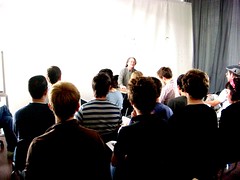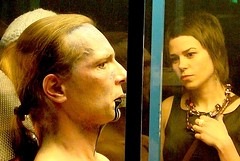Today, I joined the RCA's Design Interactions again, at the invitation of Tony Dunne. The project was on Robot Ethics this time and I gave a lecture that talked about the relations between Prosthesis, Robotics and Artificial Life. Also speaking this morning was Bruce Sterling, whom it was a delight to meet. I have read Bruce's work for some years and had email contact with him some time ago in relation to CTHEORY. After the morning sessions, we chewed the fat on urban regneration, Richard Florida, creativity and the trivialization of everything.
 Here are some notes on his talk that I made. They might be impenetrable:
Here are some notes on his talk that I made. They might be impenetrable:
Design Interactions, Oct 8 2007
Robots
Bruce Sterling
Why no humanoid reobots?
From literature and theatre
Usually, humanoid, dim witted
Can take some limited orders from humans
Contemporary robot is different
C3P0
R2D2 – drone – remotely piloted
Humanoid vs ME: non-humanoid
Terminologies blur
- both referred to as droids
androids supposed to be different – semi-biological
- form and shape of human, but semi mechanical
gianoids – women shaped mechanical objects
robot in metropolis
- blog.wired.com/sterling
- robo veganza
when robot word invented, made from goo – poured into moulds
mechanical version came later
there is one household robot you can buy – disc shaped vacuum cleaner
- animals hate them
- can get stuff on things: destroy themselves
- no brains
- no emotional relationship
- not pets
why did robot dog fail?
- people played with it then forgot to plug it in.
- Sony iBo
These objects lack common sense, so cannot have relationship with
Put a face on our relationship to technology
- cannot have moral discussion with it
- can have one with dog – but not a robot dog
does not have morality
sony also built humanoid robot, but never launched
Institute of RoboEthics, Italy
- afraid to release, for fear of hackers
‘they can dance’
There aren’t any smart machines
- none that can ustd commonsense language
- not even translating machines
no embodiment
strings of 1s and 0s
nothing remotely behaves like this, nor getting closer to it
serious advances in robots
- intelligence NO
- solving Turing Test? NO
what we’ve got is ‘arms and legs’
- big Dog – darpa project, bath tub on legs; no head
uncanny
- not a perfect version of a robot human
- reach a
Marvin Minsky
- artificial emotions
- AI doesn’t work since human brains don’t work in the way he imagined
- Must be an emotional substrate below intelligence
Robots have no sense of preservation. They don’t reproduce
They don’t value their own existence
There’s no way for us to give them anything
Minsky now emotions
Hans Moravec
- most advanced schemes ‘bush robot’ – equipped to do nanotechnology
- ‘utility fog’ – get rid of everything and keep fingers
o a kind of gas – oozing through peoples bodies
o Behind a scheme like this is difficulty and tragedy
Melancholy tale of how the word robot was invented
- invented by a painter – jozef char
satirical play about industrialism – RUR – Rossums Universal Robots
- parody of industrial production
- basic researcher and industrial technologist
- scientist decides will make a mimic of human
- first makes a dog, but doesn’t work very well
- his son says it’s not working, so suggests try making an industrial labour
- get rid of parts that would make money – no sexuality, no emotional attachment, just really good memory, doesn’t sleep, eats anything, work tirelessly on assembly line
- robot = worker
communism,
humane



